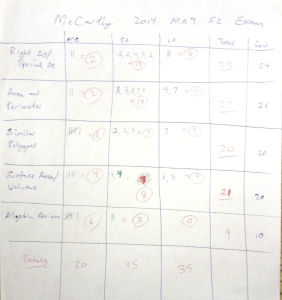How to write an exam
I returned to school last week after an unscheduled trip (family business) to find that my Math 9 exam was due into my department head and the admin … well, when I was away. No worries, off to the last years’ exams to see what I can touch up! However, looking through prior exams I noticed that about 20% of the questions were from the quadrilaterals unit, which I covered at the end of Semester 1! Uh-oh.
 That left me to create a new exam, so why not do it right? I started by trying to balance two factors, shown in the makeshift table to the left. The first is the distribution of question types: I aimed for 20 marks of multiple choice (to quickly test students’ understanding without the possibility of calculation errors), 45 marks of short answer (to most closely mirror our class- and homework and test process), and 35 of long answer (to test how students can apply and synthesize different parts of the course). The second is the distribution of questions per unit; I balanced these roughly with the percent accorded each unit in the syllabus.
That left me to create a new exam, so why not do it right? I started by trying to balance two factors, shown in the makeshift table to the left. The first is the distribution of question types: I aimed for 20 marks of multiple choice (to quickly test students’ understanding without the possibility of calculation errors), 45 marks of short answer (to most closely mirror our class- and homework and test process), and 35 of long answer (to test how students can apply and synthesize different parts of the course). The second is the distribution of questions per unit; I balanced these roughly with the percent accorded each unit in the syllabus.
I then started adding questions, each of which put marks into one box on my table. I started with the long answer questions, which were the most tricky, then moved on to the short answer. I will admit that most (but not all) of my short answer questions were lifted from the past years exams, with some numbers changed here and there. I tend to care more about math process and exact answers than decimals, so I changed some of the questions to reflect this. Lastly, I balanced the exam out with non-calculator multiple choice. A few of these included simple calculations, but most were to test understanding or course knowledge.
Throughout this process I had to balance two more subtle and less easy-to-quantify considerations: level of difficulty and level of thinking. To some extent these were varied due to the difference between question types; however, even within each section I tried to ensure that I had a few easier questions–approachable for anyone with a basic understanding of the course–and a few more difficult ones–where most students could earn part marks but it will truly require a thorough understanding to get the question correct.
Finally, I had an exam ready and had to test it out (by creating the key!). I was testing for question correctness and general test quality, but also for timing. It is a rule of thumb in the math departments where I have worked that a teacher can estimate the needed student time by taking their own time and multiplying by 3. I took extra pains through creating my key to write down every step of the process, so that I can mark consistently across all my classes. I do hope that changes the rule-of-thumb calculation, since I took just under an hour to take the test. I think my students will be able to take it in the 1 hour and 45 minutes they are given.
For obvious reasons I cannot upload the test here to accompany this post; however, I think it is a decently-crafted assessment that will reflect well what my students have learned this semester. As they say here, vamos a ver!